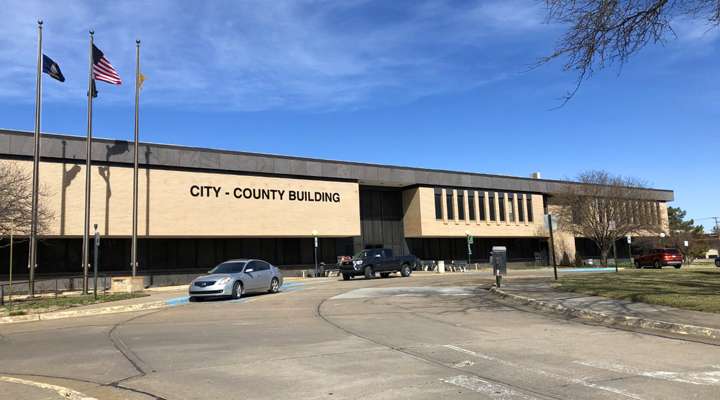
After a lengthy discussion and consideration of multiple options, the Saline County Commission on Tuesday voted unanimously to move forward with the greenfield site option for the Saline County Jail and to put a sales tax increase question on the November ballot.
Several options were given to Commissioners based on all of the extensive work that has occurred on this potential project over the last few years, according to information provided by the county. The options presented were as follows:
•Greenfield site with special election: A greenfield site is projected to be the least costly option for jail operations over the next 20 years. The incremental cost of additional staffing related to expanded bed capacity is projected at $61.01 million, with a cost savings of $1.18 million in non-personnel operational costs compared to continuing to occupy the current facility. This total cost of $59.83 million compares to a projected cost of $66.12 million for continuing to house increasing numbers of inmates outside of Saline County over the next 20 years. Holding a special election could speed up the schedule by approximately two months compared to waiting for the next general election and also provides a dedicated election cycle focused on one issue, helping minimize voter confusion and diverted attention.
•Greenfield site but combine with the November 2020 general election: This option has the potential to save $40,000 to $50,000 in election costs. However, each month of delay in the project start date is estimated to cost 0.4 to 0.5 percent of the project in terms of construction cost inflation. On a project of $89.65 million, this equates to between $740,000 and $896,500 for a two-month delay. In addition, combining the jail question onto an election that has a lot of other offices and issues on the ballot may risk voters overlooking the question.
•Two-site option: This option would allow for reuse of the existing jail site while also beginning the transition to a new, larger site. It would allow for future expansion at the new site to include Sheriff's patrol operations as well as eventual relocation of the entire jail. It is also the least-costly in terms of the project costs, although operational costs over a 20-year period are expected to be higher than the greenfield site option by $31.8 million.
•Remodel at current site: This option would eliminate the need for acquiring property in a new location. However, it is the most expensive option from an operational standpoint (more than double the cost of the greenfield option) while saving only $5.45 million in project costs compared to the greenfield option.
•No-build option: Continuing the current status quo would necessitate expenditure of approximately $8.935 million in renovations to the existing facility. In addition, as mentioned above, the cost of housing an ever-increased population of inmates outside of Saline County is anticipated to total $66.12 million over the next 20 years. Operationally, the Sheriff is concerned not just about the cost of out-of-county beds but also their availability.
•Delay a decision at the present time: Given the current lack of certainty in the economy due to the coronavirus pandemic, the County could also delay making any decision and revisit this at a later time. However, as noted above, project costs for any of the build options are estimated to increase (based on historical construction cost patterns) at 5-6% per year or 0.4-0.5% per month.
Commissioners discussed the jail project in length and providing their thoughts and concerns, the information noted. All commissioners acknowledged that this project is one that will ultimately be decided upon by the voters of Saline County. At the end of the discussion, a motion was made by Commissioner Monte Shadwick to direct staff to move forward with the greenfield site option and for the question for a sales tax increase for the building of such to be combined with the November 2020 general election. This motion passed 5-0.
Information about the jail project can be found on the county's website at www.saline.org/2020-jail-project.
Other items from Tuesday's county commission meeting include the following.
•Jason Tiller, Health Department director, provided an update to the commissioners on the COVID-19 pandemic. Tiller noted that due to a majority of the cases in Saline County not having any association with recent travel to hot spot areas or no known direct contact with other positive cases, there is a strong indication that the county has community spread, meaning people have been infected with the virus in an area, including some who are not sure how or where they became infected. Commissioner Robert Vidricksen urged citizens to stay at home and only go out to do essential tasks.
•Michelle Barkley, Emergency Management director, presented a resolution that would restrict burning in Saline County. This resolution is not a complete ban on burning, it does allow for agriculture burn permit holders to burn up to 360 acres per day. This will restrict those with an “SA” permit to not conduct burning in barrels, tree piles, or smaller burns. This restriction of burning will be in effect until April 30.
•Commissioners approved several asphalt pavement projects with an estimated cost of $1,273,625.85. Two projects are for asphalt overlays, two projects are for improvements to the asphalt approaches off gravel roadways, and three projects are for overlays on low water crossings in the county.
•Commissioners approved the addition of Teledoc services to the Saline County Health plan. This will expand services to Saline County employees to see a doctor virtually for non-emergent needs. The cost is $1.25 per month per employee that will be paid through the benefit trust fund and no additional costs to employees.
•Phil Smith-Hanes, county administrator, announced the four recipients of the Oliver Hagg Memorial Scholarship. Jennie George, Abigail Johnson, Owen Bradley, and Trista Stevenson will each receive a $1,000 scholarship to be used towards their post-secondary education in pursuing agriculture-related studies.





